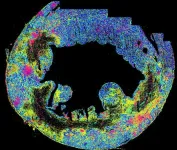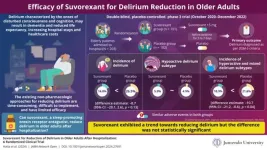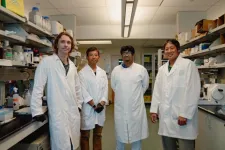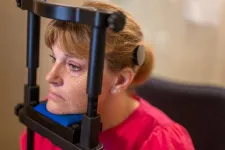(Press-News.org) COLUMBUS, Ohio – Scientists who have described in a new study the step-by-step details of a bacterial defense strategy see the mechanism as a promising platform for development of a new genome-editing method.
The system involves two proteins that team up to disable plasmids, small DNA molecules that exchange genetic information among different bacterial strains. While plasmids provide evolutionary benefits, they can also be seen by host bacteria as threats.
The research team determined that one protein uses a short piece of DNA – known as a DNA guide – to set off events that recruit another protein to chop up the plasmid.
Beyond revealing a secret to bacterial survival, the research has uncovered components that could be applied to gene editing: guide DNA, which is more stable and cheaper to synthesize than guide RNA, and a functional protein small enough to deliver into mammalian cells for DNA sensing and gene-editing purposes.
“This system has great potential to be developed into a genome-editing tool,” said Tianmin Fu, assistant professor of biological chemistry and pharmacology in The Ohio State University College of Medicine. “We’re now trying to test whether it can be reprogrammed into a useful technology.”
The paper was published on Aug. 21 in the journal Cell.
The presence of plasmids in bacteria is well-known – some bacteria secrete plasmids, and the molecules can also move from one cell to another to share genetic information.
“It’s why bacteria evolve so rapidly,” Fu said. “Sometimes, plasmids can integrate into genomic DNA, but this happens quite randomly. They might cause difficulty for individual bacterial survival, but plasmids benefit the community in the long run because genetic information allows bacteria to acquire new features.”
Still, bacteria tend to want to eliminate plasmids to prevent any random threatening actions they might take.
Fu and colleagues used Vibrio cholerae bacteria as a model for studying the plasmid defense system known as DdmDE, consisting of proteins called DdmD and DdmE, using cryo-electron microscopy to observe their functions.
The process begins with DdmE binding to a very short DNA fragment, known as guide DNA, which enables the protein to recognize a target plasmid and snag it by creating a bubble formation using one of the plasmid’s double strands. The bubble complex recruits the DdmD protein, which can bind only to the plasmid’s free remaining strand. Once bound, DdmD dissociates into two separate molecules that both function as clippers to cut the plasmid into pieces.
Preliminary data from the team’s experiments suggested that a plasmid fragment remaining after DdmD chops it up could function as a segment of guide DNA to which DdmE could bind to repeat the process.
“There appears to be a feedback loop,” Fu said. “Once you create plasmid fragments, then more DdmE can acquire the fragments as guides to target more plasmids in the cell.”
However, he added, “How the first guide was created in the cell is unclear to us at the moment. It’s a ‘chicken and egg’ situation.”
The finding was unexpected because DdmE has similar qualities to a superfamily of Argonaute proteins that trigger their host bacteria’s death to avoid plasmid invasion. Argonautes, however, are aided by guide RNA, not guide DNA – and the guide DNA is a major reason the DdmDE system is attractive as a platform for genome editing aimed at disease prevention.
“Because DdmE needs guide DNA, we can synthesize guide DNA to target a very specific area in a genome,” Fu said. “We are testing this now in mammalian cells to see whether it will work, and we do see some potential there.”
This research was supported by the National Institutes of Health.
Co-authors, all from Ohio State, include Xiao-Yuan Yang, Zhangfei Shen, Chen Wang and Kotaro Nakanishi.
#
Contact: Tianmin Fu, Fu.978@osu.edu
Written by Emily Caldwell, Caldwell.151@osu.edu; 614-292-8152
END
Crowds flocking to rivers and streams over Labor Day weekend are doing more than cooling off and having fun. They’re temporarily introducing chemicals and microscopic organisms into their local waterways, according to new research from Johns Hopkins University.
The research, published today in ACS ES&T Water, is the first holistic assessment of how recreation impacts streams. Findings also provide insight into the compounds and chemicals people are splashing around in when their favorite swimming spots are packed.
“Residue from ...
Ischemic heart disease is the most common cause of death in the world. It begins with a “heart attack”, also known as a myocardial infarction (MI), which causes part of the heart to die due to inadequate coronary blood flow. This leads to vigorous inflammation, heart wall remodeling, and heart failure.
Anti-inflammatory drugs have been surprisingly ineffective at preventing heart failure. As a consequence, they are not a routine part of post-MI care. However, it is possible that the most potent molecular and cellular inflammation targets have yet to be discovered.
In the Aug. 28, ...
Delirium is a sudden onset and temporary state of disturbed consciousness or cognition, occurring due to underlying medical issues like fever or alcohol withdrawal. It is most common among older hospitalized adults aged 75 years or above, leading to increased risk of falls, dementia, low life expectancy, and high healthcare expenses.
Non-pharmacological approaches to prevent or reduce delirium are time-consuming, hard to implement, and partially effective. So, pharmacological interventions offer hope. Insomnia, a significant risk factor for delirium, could be alleviated with sleep-promoting medications. However, not all ...
For decades, scientists have dreamt of a future where genetic diseases, such as the blood clotting disorder hemophilia, could be a thing of the past. Gene therapy, the idea of fixing faulty genes with healthy ones, has held immense promise. But a major hurdle has been finding a safe and efficient way to deliver those genes.
Now, researchers at the University of Hawaiʻi’s John A. Burns School of Medicine (JABSOM) have made a significant breakthrough in gene editing technology that could revolutionize how we treat genetic diseases. Their new method offers a faster, safer, and more efficient way to deliver healthy ...
Climate change will move and reduce the land suitable for growing food and timber, putting the production of these two vital resources into direct competition, a new study has found.
The sight of vineyards in Britain is becoming more common as hotter summers create increasingly suitable conditions for growing grapes. But behind this success story is a sobering one: climate change is shifting the regions of the world suitable for growing crops.
Researchers at the University of Cambridge have uncovered a looming issue: as the ...
University of Iowa researchers have defined how people recognize words.
In a new study with people who use cochlear implants to hear, the researchers identified three main approaches that people with or without hearing impairment use to recognize words, an essential building block for understanding spoken language. Which approach depends on the person, regardless of hearing aptitude or ability: Some wait a bit before identifying a word, while others may tussle between two or more words before deciding which word has been heard.
When a person hears a word, the brain briefly considers hundreds, if not thousands, ...
London, UK: Heart experts say that everyone should have their levels of lipoprotein (a) (Lp(a) measured routinely at least once in life, following research from one of the most populous EU countries, Poland, that shows how common high levels of Lp(a) are in the general population.
The findings come from several studies presented at the European Society of Cardiology (ESC) Congress taking place in London, UK, this week [1] and published in two journals: Progress in Cardiovascular Disease and Archives of Medical Sciences [2].
LP(a) is a parcel of fats (also known ...
Scientists have revealed how a “tag-team” between the oceans and continents millions of years ago devastated marine life – and altered the course of evolution on Earth.
Their study has unearthed a new explanation for a string of severe environmental crises, called oceanic anoxic events, which happened between 185 and 85 million years ago.
These occurred when the seas became critically depleted of dissolved oxygen.
Experts from the University of Southampton, which led the study, said these events triggered significant biological upheavals, including ...
Researchers map 50,000 of DNA’s mysterious ‘knots’ in the human genome
Innovative study of DNA’s hidden structures may open up new approaches for treatment and diagnosis of diseases, including cancer.
DNA is well-known for its double helix shape. But the human genome also contains more than 50,000 unusual ‘knot’-like DNA structures called i-motifs, researchers at the Garvan Institute of Medical Research have discovered.
Published today in The EMBO Journal is the first comprehensive map of these unique DNA structures, shedding light on their potential roles in gene regulation involved in disease.
In a landmark 2018 study, Garvan scientists ...
Chef-turned-chemist Vayu Hill-Maini has a passion: to turn food waste into culinary treats using fungi.
One of his collaborators is Rasmus Munk, head chef and co-owner of the Michelin two-star restaurant Alchemist in Copenhagen, who serves a dessert — orange-colored Neurospora mold grown on rice — inspired by Hill-Maini.
For the past two years, Hill-Maini has worked with a team of chefs at Blue Hill at Stone Barns, a Michelin two-star restaurant in Pocantico Hills, New York, to generate tasty morsels from Neurospora mold grown on grains and pulses, including the pulp left over from making oat ...








